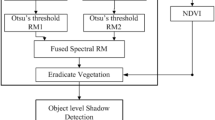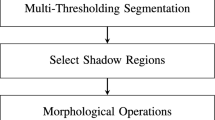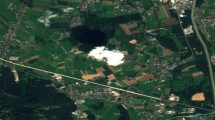Abstract
Shadow detection is a significant preprocessing work that soil species are classified with machine vision because shadow may affect the accuracy of identifying soil species. To judge the number of shadows in a soil image used for soil species identification, density peak clustering for shadow detection of soil image (DPCSDSI) is proposed to segment shadows. Firstly, the \(Bright\) histogram of a soil image is built and its Gaussian smoothing is done. Then a new parameter-free density formula and decision value measure are reconstructed. Because shadow detection is a typical binary classification problem, the two \({x_i}\) points with the largest decision value \({\gamma _i}\) are chosen as the cluster centers of shadow and non-shadow. And the clustering labels gray levels are initialized by the original DPC algorithm with the cluster centers. Next, the \(Bright\) histogram is fitted with Fourier series to search valleys and update the clustering labels. Finally, the clustering labels are corrected with uncertainty coefficient until Eq. (21) is satisfied, which finishes the segmentation of shadow and non-shadow in a soil image. The simulation results show that DPCSDSI is better than the contrast algorithms and its average brightness standard deviations of the shadow and non-shadow are, respectively, 20.5484 and 20.9024. It can detect adaptively shadows in a soil image and there is not the “domino” error propagation in it, so it is effective.






Similar content being viewed by others
Code availability
Underlying the results presented in this paper is not publicly available at this time but may be obtained from the authors upon reasonable request.
References
Rodriguez, A., Laio, A.: Clustering by fast search and find of density peaks. Science 6191, 1492–1496 (2014)
Liu, Z., Wu, C., Peng, Q., et al.: Local Peaks-based clustering algorithm in symmetric neighborhood graph. IEEE Access 99, 1 (2019)
Zhang, Y., Lu, Y.H., Huang, D.C.: Weighted hesitant fuzzy clustering based on density peaks. Comput. Sci. 01, 145–151 (2021)
Ding, S.Y., Tian, Q.Y.: Density peak clustering algorithm based on ball-tree. Comput. Eng. Appl. 01, 1–9 (2021)
Wang, F.Y., Zhang, D.S., Zhang, X.: Adaptive density peaks clustering algorithm combining with whale optimization algorithm. Comput. Eng. Appl. 03, 94–102 (2021)
Sun, L., Tao, T., Zheng, X., et al.: Combining density peaks clustering and gravitational search method to enhance data clustering. Eng. Appl. Artif. Intell. 85, 865–873 (2019)
Xu, X., Ding, S., Wang, Y., et al.: A fast density peaks clustering algorithm with sparse search. Inf. Sci. 3, 554 (2020)
Liu, R., Huang, W., Fei, Z., et al.: Constraint-based clustering by fast search and find of density peaks. Neurocomputing 22, 223–237 (2019)
Zhen, Y., Wang, H., Yu, Z.: A clustering algorithm with adaptive cut-off distance and cluster centers. Data Anal. Knowl. Discov. 03, 39–48 (2018)
Wang, Y., Zhang, G.: Automatically determine density of cluster center of peak algorithm. Comput. Eng. Appl. 08, 137–142 (2018)
Hou, J., Zhang, A.: Enhancing density peak clustering via density normalization. IEEE Trans. Ind. Inform. 99, 1–1 (2019)
Weng, Y., Zhang, N., Yang, X.: Improved density peak clustering based on information entropy for ancient character images. IEEE Access 99, 1–1 (2019)
Jiang, D., Zang, W., Sun, R., et al.: Adaptive density peaks clustering based on K-nearest neighbor and Gini coefficient. IEEE Access 99, 1–1 (2020)
Chun, R., Li, S., Yu, Y., et al.: Effective Density peaks clustering algorithm based on the layered k-nearest neighbors and subcluster merging. IEEE Access 99, 1–1 (2020)
Liang, Z., Chen, P.: Delta-density based clustering with a divide-and-conquer strategy: 3DC clustering. Pattern Recogn. Lett. 1, 52–59 (2016)
Liu, Y., Ma, Z., Yu, F.: Adaptive density peak clustering based on K nearest neighbors with aggregating strategy. Knowl.-Based Syst. 1, 208–220 (2017)
Zeng, S.H., Tang, W.M., Zhan, L.Q., et al.: Color image segmentation of field purple soil based on adaptive density peaks clustering. Trans. Chin. Soc. Agric. Eng. 19, 200–208 (2019)
Flores, K.G., Garza, S.E.: Density peaks clustering with gap-based automatic center detection. Knowl.-Based Syst. 206, 106350 (2020)
Fang, F., Qiu, L., Yuan, S.: Adaptive core fusion-based density peak clustering for complex data with arbitrary shapes and densities. Pattern Recognit. 107, 107452 (2020)
Li, Q.Y., Wang, N.C., Yi, D.Q.: Numerical Analysis. Tsinghua University Press, Beijing (2008)
Wang, S. et al.: DB50T 796-2017 Classfication and Codes for Chongqing soil. Chongqing Bureau of Technical Supervision (2017)
Tsai, V.J.D.: A comparative study on shadow compensation of color aerial images in invariant color models. IEEE Trans. Geosci. Remote Sens. 6, 1661–1671 (2006)
Acknowledgements
This work supported by the Key Science and Technology Research Program (No. KJZD-K201900505) and Chongqing University Innovation Research Group funding (No. CXQT20015) of Chongqing Municipal Education Commission, China.
Author information
Authors and Affiliations
Corresponding author
Ethics declarations
Conflict of interest
The authors declare that they have no conflict of interest.
Additional information
Publisher's Note
Springer Nature remains neutral with regard to jurisdictional claims in published maps and institutional affiliations.
Rights and permissions
About this article
Cite this article
Zeng, S., Wang, Q., Wang, S. et al. Density peak clustering for shadow detection of soil image. SIViP 17, 839–847 (2023). https://doi.org/10.1007/s11760-022-02296-y
Received:
Revised:
Accepted:
Published:
Issue Date:
DOI: https://doi.org/10.1007/s11760-022-02296-y




